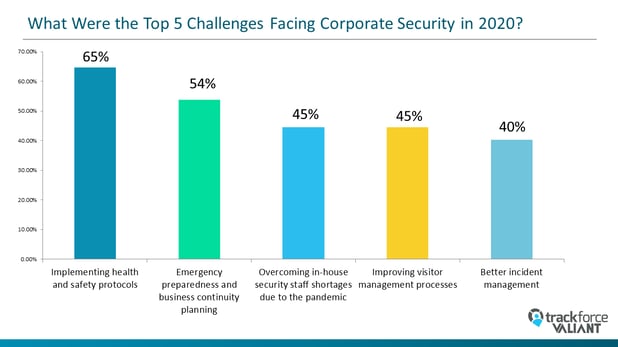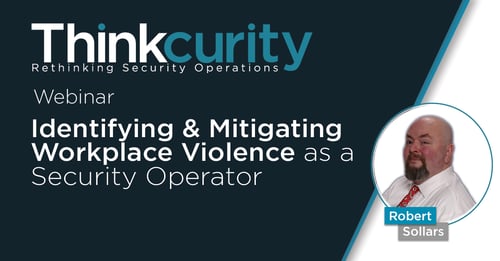This is our second installment of our 3-part series discussing the state of corporate security in 2021. In an effort to uncover trends and initiatives for corporate security executives, we looked at a recent benchmark report released by Trackforce Valiant that analyzed data from over 350 corporate security executives.
There is a Direct Correlation between 2020 Challenges and 2021 Priorities
In reviewing the data from the study two things stood out with this particular question. The first is the stark similarity of the 2020 challenges to the 2021 priorities. The second is the higher percentage of what was considered a “major priority” for corporate security executives.
While in the previous article, only 40-60% of respondents listed out what they considered “major challenges”, roughly 85% of respondents list similar initiatives as a major priority. More and more executives see these as very important to their business, even if it wasn’t a significant challenge for all of them.
The 5 Priorities for Corporate Security Teams in 2021

- Implementing health & safety protocols
- Emergency preparedness and business continuity planning
- Conducting risk assessments and audits
- Better incident management
- Training and processes to prevent workplace violence
Three priorities in this list – implementing health and safety protocols, emergency preparedness and incident management – were also listed as the top challenges of corporate security teams in 2020. This article will cover the remaining two: conducting risk assessments and audits and training and processes to prevent workplace violence.
If you want to read the whole report, click below to get your free copy.
 Conducting Risk Assessments and Audits
Conducting Risk Assessments and Audits
Expecting the unexpected is always a challenge. Professionals from any industry look for ways to identify, mitigate and prevent risks before they happen. Security risk assessments allow for a quantifiable and proactive approach to looking at potential failure points. As more and more corporate security teams adopt risk management strategies similar to their health and safety counterparts, conducting audits to find hazards in the company is critical.
One tool corporate security leaders are using right now is a security risk matrix. A risk matrix helps quantify risk mitigation strategy and organizes company-wide risk teams to analyze and take action. With a risk matrix, corporate security leaders create action plans to mitigate those risks and to analyze other facilities that have similar risks.
Download this Resource on Revamping Your Risk Management Plan
Training and processes to prevent workplace violence:
A study done by the CDC last year tied the effects of COVID-19 to overall wellness. It said that 40% of U.S. adults reported struggling with mental health or substance abuse. Now, as the majority of the workforce begins to return to offices and facilities, those issues remain.
ASIS recently wrote an article on the impact returning to work might have on the security role. They found that as members of the workforce who were isolated for so long start to come back together, there is a higher potential for workplace violence.
In light of that fact, security guards will not just be seen as a threat deterrent like they once were; security is a protector, a health and safety officer, and needs to become aware and vigilant of employee wellbeing. Identifying workplace violence warning signs is another role to be played within the team.
 2021 Priorities Highlight more Prevention to Limit Risk
2021 Priorities Highlight more Prevention to Limit Risk
Not only have corporate security teams begun to look at extended health and safety while building out emergency plans, but leaders are also addressing risk mitigation as a large component of their 2021 strategies. With the events of 2020 fresh in our collective minds, the theme for 2021 is about proactive prevention.
Security risk assessments and audits seek to identify potential threats that may occur and put in place controls to ensure they do not occur. Similarly, this calls for a priority shift to workplace violence training. We are living in tense times; there is a lot of stress, anxiety, and fear. These emotions have been a part of the world narrative for over a year now. As people begin to integrate back to workplaces, these issues will come back with them. Security officers need to be vigilant and mindful of potential risks to violence and know how to de-escalate them as professionally and quickly as possible.
So far, we’ve talked about people and processes as they relate to corporate security priorities. In our final installment, we are going to look at the technology side of 2021 corporate security team initiatives. We will look at the current and planned security technology integrations for this year and see how it all ties into the overall corporate security mindset.
 About the Research: The research team conducted a survey to over 350 corporate security executives across a multitude of industries to ask about their top challenges and adaptations for 2020 and 2021. The majority of roles ranged from manager level and above, with companies spanning 200 employees to well over 10,000. While the majority were solely responsible for physical security at their company, some worked in both physical and cybersecurity and had a good range of the number of locations they managed and the number of guards per location. It was from this group the research team built the study.
About the Research: The research team conducted a survey to over 350 corporate security executives across a multitude of industries to ask about their top challenges and adaptations for 2020 and 2021. The majority of roles ranged from manager level and above, with companies spanning 200 employees to well over 10,000. While the majority were solely responsible for physical security at their company, some worked in both physical and cybersecurity and had a good range of the number of locations they managed and the number of guards per location. It was from this group the research team built the study.



